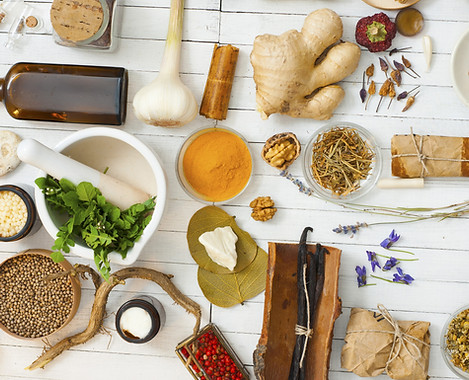What is Ayurveda?

Ayurveda is a holistic health care system that originated in India 5000 years ago. It treats the root cause of a health problem rather than just addressing the symptoms. By combining diet, yoga, massage, detoxification, herbal remedies and meditation into our daily lifestyle it will gently bring into back into balance our bodies both physically and mentally.
It believes that prevention is better than cure and that if we can understand our natural tendencies, learn our strengths and recognise our weaknesses we will be able to live a happier and more healthy life. It is the ideal way for healthy individuals to maintain good health and general well being.

BRIEF HISTORY OF Ayurveda?

The knowledge of Ayurveda comes from the Vedas which are a body of texts composed in Sanskrit and originated in India. Ayurveda when literally translated means "life" ayu and "science" veda and this system of medicine was taught to students who visited the great teachers in India. This knowledge was passed down through the ages from one generation to the next in the form of sutras meaning "thread" in families where parents, children and grand parents all lived under one roof.
One of the main principles in Ayurveda is that everything in the universe is composed of the five great elements: Space, Air, Fire, Water and Earth. These are the building blocks of our world and combine giving rise to three bio-physical forces or Doshas within our body.

TRIDOSHA

These five elements then combine with each other, giving rise to three bio-physical forces - the Doshas within the human body- Vata (air and space), Pitta (fire and water) and Kapha (water and earth). Together they are known as Tridosha and govern all the biological, physiological and psychological functions of the mind, body and spirit as well as effecting how an individual interacts with the environment.
Each of us has within us all three Doshas, but it is the dominance of any one or two or all three that dictates our individual constitution or Prakriti.
Although a person's Dosha is determined at the moment of conception, it is dynamic and can fluctuate according to environmental changes, a person's age and even the time of day. Dosha dominance is constantly shifting within the body.
Ayurveda seeks to treat the mind and body according to a person's Dosha using a system combining diet, herbal remedies, detoxification, Yoga, Ayurvedic massage, lifestyle routine and behaviours which stimulate positive emotions.
Vata Dosha represents change and movement in all living organisms and is a combination of the elements: air and space. Vata Dosha is closely related to the nervous system.
According to Ayurveda, the main characteristics of Vata Dosha in any person are:
Mobility - Generally quick actions, rapid movement and speech, restless eyes, likes to travel and frequently has mood swings.
Dryness - Dry body (including skin, hair, nails and lips), a tendency towards constipation because of dryness.
Coldness - Dislike towards cold weather, generally cold feet and hands, a tendency towards poor blood circulation.
Lightness - Generally underweight, thin physique (bones and muscles), light sleeper.
Roughness - Rough and cracked skin, nails, hair feet and hand, a tendency towards cracking joints.
Some of the bodily functions ruled by Vata Dosha are:
-
physical movement
-
respiration
-
starts activities and processes in the body
-
stimulation of Agni (digestive fire)
-
excretion
-
development of the embryo
-
sensory perception
-
speech
-
hearing
-
adaptability
-
enthusiasm
-
affection
-
creativity
-
spontaneity
The imbalance created by excess Vata Dosha can be exacerbated by:
-
stress, over-exertion, or pressure
-
irregular daily routine and mealtimes
-
late nights
-
raw, cold or dry foods
-
excess coffee, tea, fizzy drinks
-
excess alcohol
-
long journeys
-
cold, windy weather, notably during autumn or winter months
Vata Dosha can be balanced by:
-
regularity in everyday life, including sleep and meal times
-
time for relaxation
-
warm, nourishing foods with sweet, sour and salty tastes
-
moderate alcohol intake
-
staying warm in cold weather
-
Ayurvedic massages

Kapha Dosha is the principle of stability and maintenance in any living organism and is a combination of the elements water and earth. Kapha Dosha is closely related to the lymphatic and immune system in the body and is responsible for the growth of the individual.
The main characteristics of Kapha Dosha in any person are:
Heaviness - Deep voice, tendency towards obesity, large and heavy body, bones and muscles.
Coolness - Cold skin, tendency towards attacks of cold, slow metabolism leading to reduced appetite and thirst.
Softness - Soft skin and hair and tendency toward soft tender nails. Loving, caring and kind attitude.
Oiliness - Oily body including skin, hair, nails, stools. Flexible and mobile joints.
Sweetness - Tendency towards excess intake of sweet foods and drinks. Good anabolic state of the body.
Stability - Patient and relaxed attitude. Firm decisions. Likes sedentary activities like reading, watching television etc.
Sliminess - Excess salivation, thick slimy secretion when suffering from a cold. Thick joints with good mobility.
Some of the bodily functions ruled by Kapha Dosha are:
-
strength
-
maintenance of health
-
maintenance of the joint functions (synovial fluid)
-
smell
-
taste
-
anabolism and growth
-
potency
-
stability
-
nutrition
-
absorption
-
immunity
-
satisfaction
-
tolerance
Pitta Dosha represents transformation and is a combination of the elements fire and water. Pitta Dosha is closely related to the digestive system, metabolism, enzymes and glands in the body.
The main characteristics of Pitta Dosha in any person are:
Heat - Healthy appetite, effective digestion, above average body temperature, heat intolerance, early greying of hair.
Oiliness - Soft, oily skin. Dislike of oily food.
Fluidity - Excess elimination including sweating, passing of urine, loose stools with a tendency towards diarrhoea, excess thirst.
Sour - Acidity, teeth sensitive towards sour fruits, excess salivation. Tendency towards burping.
Sharpness - Accurate memory, sharp teeth and sharp facial features with a pointed nose and penetrating eyes.
Pungent - Burning sensation on the skin, including eyes, throat and stomach. Prone to feelings of anger and hatred.
Spreading - Spread of any infection around the body like a rash or acne. Seeking recognition.
Some of the bodily functions ruled by Pitta Dosha are:
-
digestion
-
metabolism
-
vision
-
heat and energy production
-
skin lustre
-
hunger
-
thirst
-
intelligence
-
courage
-
anger
The imbalance created by excess Pitta Dosha can be exacerbated by:
-
anger
-
extremes of sour, salty and spicy food
-
excess coffee, tea, alcohol
-
loud aggressive music
-
excessive direct sunlight or heat especially during summer months
